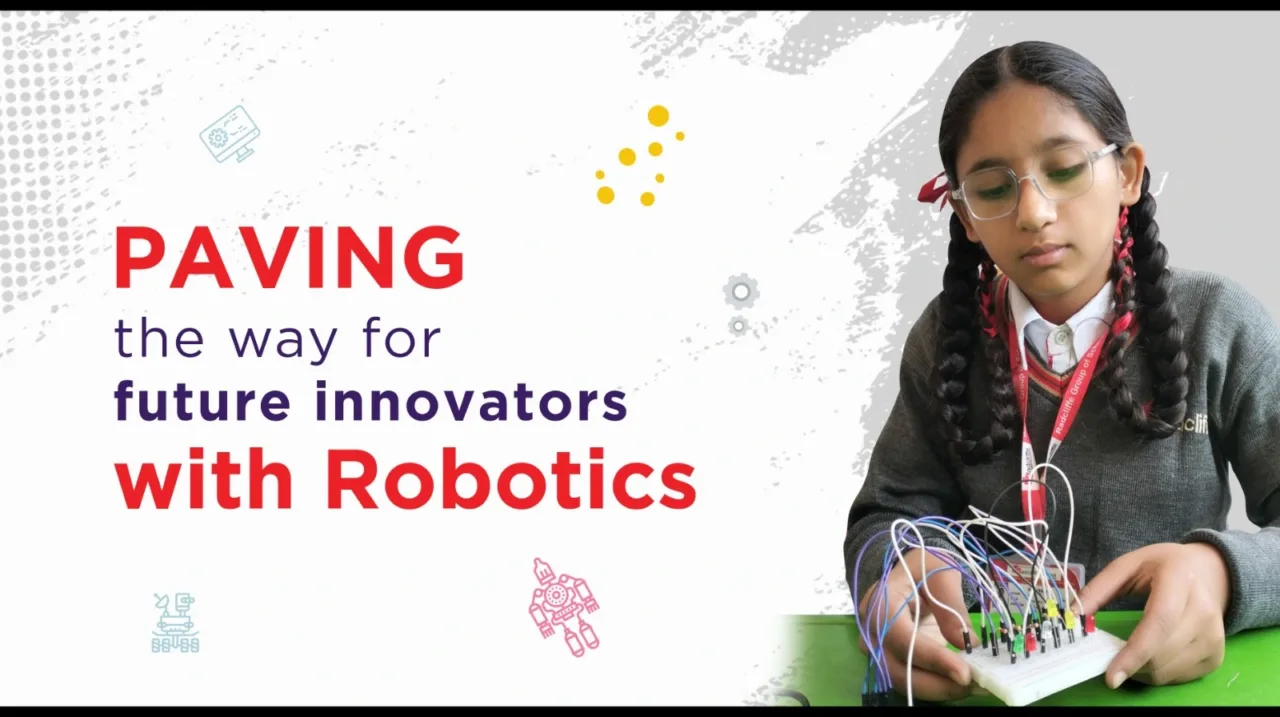The world of robotics is a fascinating realm where creativity meets technology, and innovation knows no bounds. In this era of rapid advancements, the Radcliffe Group of Schools stands out for its commitment to nurturing young minds in the field of robotics. The Robo Fest organized by Radcliffe is a testament to the school’s dedication to fostering a culture of innovation and hands-on learning. As students delve into the realm of robotics, they not only expand their technical skills but also ignite their passion for exploration and discovery.
Robotics: Why and How?
The Robo Fest at Radcliffe Group of Schools serves as a compelling platform for students to delve into the realm of robotics and automation, fostering creativity, problem-solving skills, and teamwork.
- By integrating robotics into the educational curriculum, schools can provide students with hands-on learning experiences that are both engaging and impactful.
- The Robo Fest not only encourages students to think critically and analytically but also promotes innovation and technological literacy.
- By actively participating in such events, students can unleash their potential, develop essential STEM (science, technology, engineering, and mathematics) skills, and prepare for a future that is increasingly driven by technology.
Projects Made by our Students
The students have engaged in a variety of projects, showcasing their creativity and technical skills.
- Doorbell: Utilized components such as buzzer, breadboard, push button, wires, battery, and resistors to create a functional doorbell.
- Lighting up Multiple LEDs in Series: Demonstrated the use of a breadboard, LEDs, wires, battery, and resistors to illuminate multiple LEDs in a sequential manner.
- LEDs using Switch: Utilized LEDs, breadboard, push buttons, and battery to illuminate LEDs using a switch mechanism.
- Diwali Light: Lit up LEDs one by one using components like LEDs, breadboard, resistors, wires, battery, USB cable, Arduino UNO, and laptop.
- Creating Traffic Light using RGB: Integrated components such as buzzer, breadboard, push button, wires, resistors, USB cable, Arduino UNO, and laptop to create a functional traffic light system.
- Blinking all LEDs Together: Showcased the synchronization of LEDs using a breadboard, LEDs, wires, resistors, USB cable, Arduino UNO, and laptop.
- Smart Plant Monitoring System: Developed a system for monitoring plant health using advanced technology and components.
- Smart Door Lock: Designed a secure door locking system with innovative features and technologies.
- Smart Parking System Using IR Sensor: Implemented an intelligent parking system based on infrared sensor technology.
- Water Level Alerting System: Created a system to alert users about water levels using sensors and alarms.
- Blind Stick (LDR and IR Sensor): Designed a smart walking stick using light and infrared sensors for visually impaired individuals.
- Temperature and Humidity Monitoring System: Developed a system to monitor temperature and humidity levels in a specified environment.
- Measure The Distance by Using Ultrasonic Sensors: Implemented ultrasonic sensors to measure distances accurately and displayed the results on a serial monitor.
- Make Your Own Switch: Constructed a custom switch for various applications using available components.
- Periscope: Built a periscope for observing distant objects using mirrors and lenses.
- Levitating Magnets: Demonstrated the principles of magnetism by creating levitating magnets.
- Table Fan: Designed a functional table fan using motor and blades.
- Water Conductivity: Explored water conductivity using sensors and a monitoring system.
- Catapult: Created a simple catapult mechanism for launching objects.
- Simple Pull & Push Experiment: Demonstrated basic mechanical principles through a pull and push experiment.
- Spinning Disc Motor Illusion: Created an optical illusion using a spinning disc and motor.
- Slingshot Car: Built a slingshot-powered car for dynamic movement.
- Defining Gravity with Magnets: Explored the interaction between magnets and gravity to demonstrate scientific principles.
- Earthquake Alarm: Developed an alarm system to detect and alert users of earthquake vibrations.
- Windmill: Built a working windmill model to harness wind energy.
- Magnetic Car: Designed a car prototype that utilizes magnetism for movement.
- LED Switch: Created a switch mechanism using LEDs for visual indication.
- Hypnotizing Wheel: Constructed a hypnotizing wheel using innovative design and components.
- Buzzer: Utilized a buzzer for generating sound signals in various projects.
Realizing the Learning Outcomes of Robo Fest Participation
Participating in the Robo Fest has provided students with invaluable learning outcomes that go beyond traditional classroom education. Through their involvement in various projects and activities, students have not only honed their technical skills but have also developed essential abilities such as problem-solving, critical thinking, teamwork, and creativity. By applying theoretical knowledge to hands-on projects, students have gained practical experience in electronics, programming, and engineering concepts.
Furthermore, the Robo Fest has encouraged students to explore new ideas, push their boundaries, and cultivate a passion for innovation and technology. Overall, the event has empowered students to become well-rounded individuals with a deep understanding of STEM fields and the confidence to tackle real-world challenges with ingenuity and determination.
Embracing Robotics: Integrating Technology into the Curriculum at Radcliffe Group of Schools
At Radcliffe Group of Schools, we recognize the transformative power of robotics in education and the indispensable role it plays in preparing students for the future. By incorporating robotics into our curriculum, we aim to provide our students with a holistic learning experience that goes beyond traditional textbooks. Robotics enhances critical thinking, problem-solving, creativity, and collaboration skills among students. It stimulates curiosity and fosters a passion for STEM fields, laying a strong foundation for future success in a technologically-driven world. By integrating robotics into our educational framework, we are not only equipping students with practical skills but also instilling in them a sense of innovation, adaptability, and readiness to navigate the challenges of the 21st century. Radcliffe Group of Schools is committed to nurturing well-rounded individuals who are well-prepared to embrace the opportunities and complexities of the modern world, and we believe that robotics education is a key component in achieving this vision.
Conclusion:
In conclusion, the integration of robotics into the curriculum at Radcliffe Group of Schools represents a significant step towards preparing students for the challenges and opportunities of the future. By fostering a culture of innovation, creativity, and hands-on learning, the school is equipping students with essential skills and knowledge to thrive in a rapidly evolving technological landscape. The commitment to embracing robotics education exemplifies Radcliffe’s dedication to nurturing well-rounded individuals prepared to navigate the complexities of the modern world.




